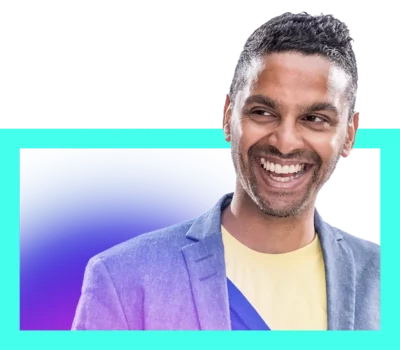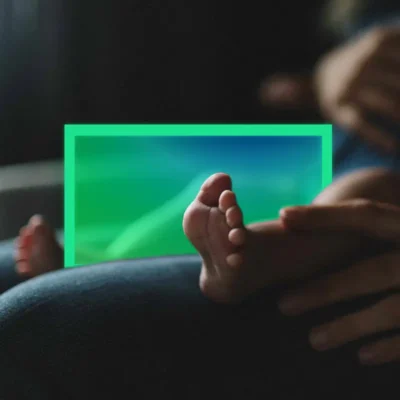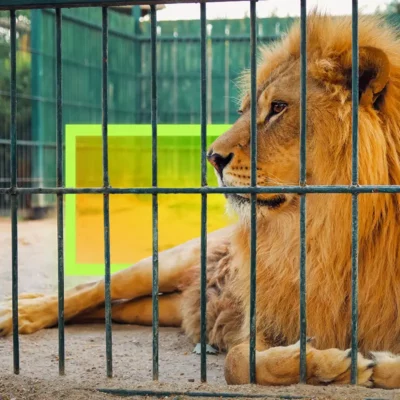Practice taming your fear
“Are you going to do this? Ever?” Standing at the edge of the highest diving board at the aquatic center, a young Adam Grant tries and tries, and tries to leap off. But he can’t face down his fear – not so much of falling as losing control. So there he stands at the end of the board, paralyzed. In this story, Adam Grant, now a famed organizational psychologist, shares how a wise diving coach helped him outsmart fear – and take the leap.
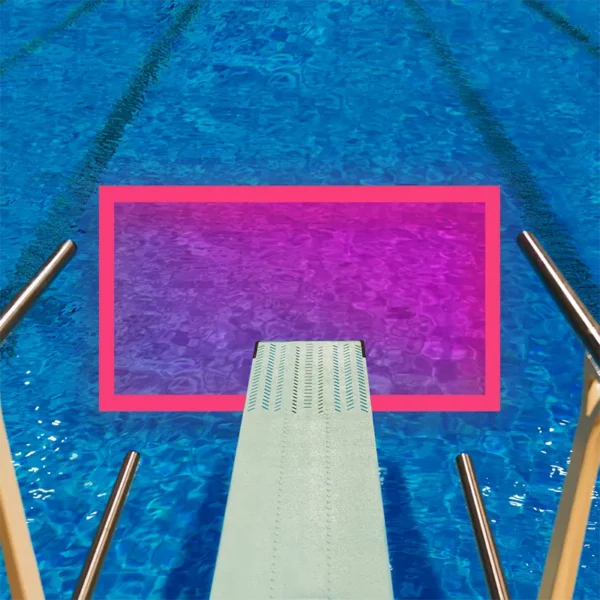
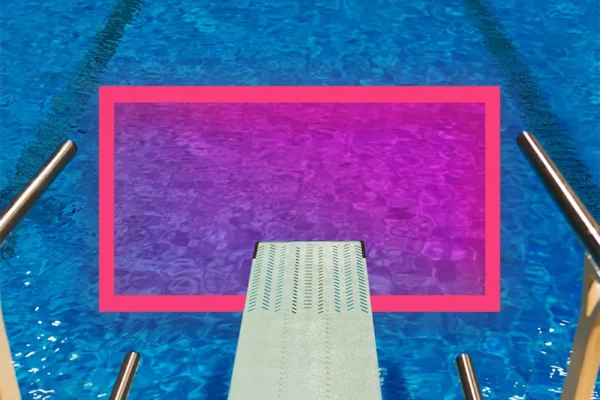
Table of Contents:
Transcript:
Practice taming your fear
ADAM GRANT: My focused practice, hour after hour, day after day, gives me a sense of clarity and purpose. I’m trying to learn a front one-and-a-half – so a flip and dive – but I am afraid to keep rotating past the flip. I’m not sure what I think is going to happen. But I’m so terrified that I only do a front one-and-a-quarter and just belly-flop. Try after try. The whole summer.
I feel like I’m hanging on a little bit longer each time. But the tapes show me I’m not. I think I’m learning to let go of control, but I’m still gripping it just as tightly. I think I’m confronting my fear, but I’m actually powerless against it.
ROHAN GUNATILLAKE: Adam Grant is a professor of organizational psychology at Wharton, a treasured TED speaker, and a multiple New York Times bestselling author. In his newest book, Think Again, Adam weaves together research and storytelling to help us stay curious enough about the world to actually change it.
In today’s Meditative Story, Adam takes us to the end of a springboard. Staring down at the water below, a long line of impatient divers behind him, he discovers that you don’t outgrow fear, you outsmart it.
In this series, we combine immersive first-person stories and breathtaking music with the science-backed benefits of mindfulness practice. From WaitWhat and Thrive Global, this is Meditative Story. I’m Rohan, and I’ll be your guide.
The body relaxed. The body breathing. Your senses open. Your mind open. Meeting the world.
GRANT: I sit on the floor of our den and stare up at the TV. It’s 10:00 AM. My Nintendo controller is in my hands where it belongs.
I’m on the third-to-last boss in Mortal Kombat. I hear footsteps enter the room from the doorway on my left, but I don’t look up.
At that moment, I hear a voice, “Okay, we’re getting out of the house today.”
“Mom! Only two boss battles to go before I beat the game.”
“You need some fresh air. We’re going swimming today.” She crosses her arms.
I’ve spent my summer mastering every character in Mortal Kombat II for Super Nintendo. As I figure out each move, I practice it over and over again, until I execute it flawlessly. I’m only 13, but when I enter a tournament, I make the final three, beating a bunch of adults and winning a lifetime free pass to a movie theater – which I will never use.
“You spent 7 hours in front of this screen yesterday. Eight hours the day before. We’re going swimming.”
My mom thinks I’m just “playing video games,” but I’m not. I’m breaking down every part of the game, analyzing it, and then putting it all back together in order to win. Mom calls it my “Nintendo fixation.” For me, it’s simple: I have a goal, and I’m determined to achieve it. Do not stand in the way of me and my goals.
But this is one battle I am not going to win.
I turn off the game, sulk up to my room to get my bathing suit, and stare at the ground as I walk to the car. We drive in complete silence.
The pool is packed. I’m too old to be coming to the pool with my mom. I try to stay as far away from her as much as possible. My mom finally finds a lawn chair where she can lay out in the sun. By the shallow end, where there are a ton of younger kids playing. My eyes fix on the diving well in the deep end.
I notice a lifeguard walk from his stand to the stairs of the diving board. He looks like a senior in high school. There’s something about the way he moves that makes me wonder what he’s going to do next. He looks powerful, but also graceful. The opposite of me.
The lifeguard walks down the board. He leaps up, lands at the end of the board, and hurls himself into a ball. I try to count the flips, but he’s spinning so fast all I can see is a blur. Suddenly, he straightens out and disappears headfirst into the water, without a splash.
I’m mesmerized. I’ve seen Olympic diving on TV, but it’s completely different up close. I wonder if I could learn to do that? I run-walk across the slippery pool deck as fast as I can to tell my Mom I want to take diving lessons. She says, “Well, why don’t you go see if that lifeguard offers them.”
As it turns out, he doesn’t even work at the pool. He’s subbing for somebody today only – so this is the one day, all summer that I could have possibly caught him diving. He agrees to give me lessons.
The timing of this is crazy. I don’t believe in fate, but maybe this was meant to be?
Diving is an interesting choice for me. I’m terrified of heights. Rewind to the previous school year: I’m on a field trip with my class at the Sears Tower in Chicago. The elevator doors open on the 103rd floor, and I take one step into the cavernous, panoramic skydeck room and just stop. People have to walk around me just to get out of the elevator. I refuse to go anywhere near the windows.
It’s not the height itself that scares me. I’m afraid of falling.
GUNATILLAKE: Spectacular long views across the city, but unable to see them for the fear and constriction. Do you have a go-to thing you do when you notice fear arising? If you do, try it now. Or try what I do, and turn your attention to whatever is happening in your experience, acknowledging it, the light of awareness taking away much of its power.
GRANT: Amusement park rides scare me. I haven’t even gotten on my first roller coaster yet. If you can picture a risk-taker, I’m the opposite. Plus, I’m awkward. I can’t dance, and sometimes I even feel goofy walking.
None of this matters to me now. I’m obsessed with diving: jumping into the air, touching my toes without bending my knees, folding out of the pike in time to vanish into the water.
The rest of the summer, I beg my mom to take me to the pool every single day. As soon as it opens, I’m there. I stay into the evenings, when everyone else is gone, and it’s dark. They have to switch on the big outdoor lights just for me.
I love the smell of chlorine in the air. The bounce that lifts me up off the springboard. The feeling of weightlessness at the top of my dive. The sensation of punching a hole in the water that’s just big enough for my body to go through. The entry, drowning out every other sound as my ears submerge.
My friend Kaan starts diving with me. One day he brings a video camera so we can record our dives. Studying the tapes late at night, I see that I’m making the same mistakes over and over. I want to fix them. If I can control something completely, I can excel at it. Like Mortal Kombat. Like school. My mom often tells me, “No matter what grade you get, as long as you try your hardest, I’ll be proud of you.” Then she adds, “But if you don’t get an A, I’ll know you didn’t try your hardest.”
So I keep trying. My focused practice, hour after hour, day after day, gives me a sense of clarity and purpose.
I’m trying to learn a front one-and-a-half, so a flip and dive, but I am afraid to keep rotating past the flip. I’m not sure what I think is going to happen. But I’m so terrified that I only do a front one-and-a-quarter and just belly-flop. Try after try. The whole summer.
I feel like I’m hanging on a little bit longer each time. But the tapes show me I’m not. I think I’m learning to let go of control, but I’m still gripping it just as tightly. I think I’m confronting my fear, but I’m actually powerless against it.
The thing is: I love sports more than they love me.
I’m a nerdy kid. I want to find a way to impress people. But the fact that I’m not even five-feet tall and lack natural talent keeps getting in my way.
In middle school, I fail to make the basketball team all three years – even though I’ve spent thousands of hours shooting on my driveway. When high school starts, I fail to make the soccer team, even though I’ve been playing for 9 years and got good enough to join a travel team.
So when the day arrives for my high school’s swimming and diving tryouts, I think,“This is it.” I’ll show off what I can do. Give it everything I have.
At the end of the tryouts, the coach, Eric Best, comes over to me. He says, “I’ve good news and bad news. What do you want first?”
“Definitely the bad news.”
He says, “Well, diving requires a few things: flexibility, explosive power, and grace. You can hardly touch your toes without bending your knees, my grandmother can jump higher than you, and you walk like Frankenstein.”
I’m like, “Is there good news?”
He says, “Yeah, diving’s a nerd sport. It attracts people who are too weak for football, too slow for track, too short for basketball. And I think if you make this a real priority, you can become a good diver. I will never cut someone who wants to be here.”
And he says, “I have a goal for you. By senior year, you’re going to be a state finalist.”
I’m shocked. But Eric has coached an NCAA champion and Olympian. He knows what he’s doing. He’s dead serious. And now, so am I.
It’s three years later. I stand on the three-meter springboard at practice. All the way back, as far away from the water as possible. My stomach is full of butterflies, and I’m shaking.
I go through all my nervous rituals. I repeatedly dry off my legs with my sammy, that spongy, squeezable towel that I used to think was for washing cars. I scratch my back involuntarily. I clear my throat and cough a few times.
I take a breath, begin taking the steps of my approach, do my hurdle to get maximum bounce on the board, and then, I stop myself before actually diving in. I’m still on the board. I’ve balked. I bail on the dive.
I fall in the water and get back in line. When it’s my turn again, the same thing happens. I’m trying to work up the nerve to actually try the dive. It’s a full-twisting front two-and-a-half tuck. Two somersaults, a full turn, and a dive. I have to do the first flip in a ball, then kick out and do a 360-degree twist during the second flip with my body straight, and then fall in the water headfirst.
Every time I try a new dive, I start the back-scratching and throat-clearing and freezing-up all over again. When you’re learning a new dive, it’s easy to get lost and just smack. Getting lost means you’re spinning and you don’t know which way the water is.
I don’t know which way is up. I don’t know where I’m going. That loss of control is my least favorite feeling. The smack hurts like hell, but eventually it ends. The loss of control, it stays with me. It haunts me. At least once a week I jolt awake with a recurring nightmare where I’m spinning, completely lost in the air, about to crash on the pool.
Back on the diving board, a minute passes. Then five minutes. Over the next 15 minutes, I start and stop three more times, and spend most of the long time just standing there, waiting for my fear to go away. I will myself to go. I’m determined to do it. But when I reach the end of the board, I chicken out. I stop.
I think, “Okay, maybe in five more minutes, I’ll be over it.” But I’m not any less scared five minutes later. I am, actually, more afraid.
Finally, Eric says, “Look, you’re wasting time. If you’re not going to go, get off the board, and get back in line when you’re ready.” In the echoey aquatic center, his words come at me from all sides, ricocheting off the walls, propelling me forward.
I walk to the end of the board… and jump into the water, feet first.
Eric cares. He’s determined to help me confront my fears.
He’s a high school physics teacher, and he knows I love to analyze problems. He breaks down the mechanics of the dive for me. My rate of acceleration. My rate of descent. How high I jump, how fast I rotate.
Math. Yes. That reassures me.
Other times, when I am up there on the board for five or 10 or 20 minutes, he appeals to my competitive drive by naming out a diver at another school and saying, “I bet that guy doesn’t stand on the board all day.”
Rivalry. Yes. That motivates me.
When that doesn’t work, he says, “Look, Adam, I’m never going to punish you for standing on the board forever, but I do want there to be consequences if you waste your time and everyone else’s. So every time you balk twice or spend more than five minutes on the board, you’re going to do five lineups.” Line-ups are just simple dives off the starting block where you focus on your entry. I probably do 10,000 lineups in my first three-month season. That’s more than some divers do over the course of their lifetime.
One day when I’m standing and shaking on the springboard, Eric tries something that changes everything.
He says, “All right. Adam, let me ask you a question. Are you going to do this dive one day? Will you ever try this dive?”
I say, “Yeah, of course. Obviously I’m going to do it. It’s part of what I need to do to get to the next level. I’ve been visualizing this dive for months. I’ve literally had dreams about learning. Of course I’m going to do it.”
Then he says, “Well, what are you waiting for? Wouldn’t you rather have done it than stand here all day, worrying about doing it?”
He’s right. I will do this dive at some point. But there won’t be a magic day when the butterflies go away, when the fear disappears. There will simply be a day when I choose to do it anyway. And that day could be today.
GUNATILLAKE: See the new confidence and belief that Adam now has. See if you can mirror these qualities in your own body. Breathing soft. Breathing, this thing that can influence body and mind. Letting its softness, relax all parts of you.
GRANT: I climb the ladder, grip the curved handrails, and step onto the board one more time. I take a deep breath, feeling the scratchy surface of the springboard on the bottoms of my feet. I take the first steps of my approach – left, right, left, right. I jump off my right foot, lifting my left knee upward, and land at the end of the board. As I bend my knees to jump, I swing my arms around in a circle until they’re up above my head. I throw them forward as hard as I can to start spinning and grab my shins in a ball, tucking just like that lifeguard did a few years earlier.
As I spin, I hear Eric shout: “Twist!” I kick my legs out and pull my arms in to the left like a figure skater. The fluid in my inner ear bounces around, telling me when I’ve completed a full turn. I throw my arms out to the sides to stop the rotation. Then I straighten them over my head and grab my hands together. I hear the beautiful “rip” sound as I enter the water. A few bubbles pop to the surface. I’ve done it.
I’m one of the team captains. When I give the first real speech of my life, I’m at the podium for our awards banquet, I don’t expect to be scared. But there it is again – I’m terrified. I’ve never done this before. It’s new.
But the feeling’s not. My stomach is too contorted to eat a bite of the banquet chicken on my plate. My knees are shaking under the table while sitting with my teammates waiting to speak. But then I get up. I know I can’t just stand there at the podium saying nothing. Some of the funny, paper plate awards I hand out to my teammates get laughs. I start to relax.
And at that moment, the diver in me realizes: The fear never goes away. There’s never a time after the fear. But there are ways to tame the fear.
That idea helps me become a state finalist. I end up making it my junior year, finishing eighth in the state, and again my senior year. I qualify for the junior Olympic nationals twice and make the All-American list. I get recruited to compete at the NCAA level. And later in life, it’s what helps me teach my first college class, to show up for my first TV appearance, to give my first TED talk.
The diver in me, who is always there, remembers: Each first time, I’m terrified.
Fear isn’t something that passes with time. It’s something you have to choose to move past. When I’m sitting in a green room, backstage before a big event, my body feels the same tension, the same discomfort, and the same anxiety as when I was frozen on the end of the springboard with the whole team watching.
But now, like then, I hear Eric’s voice: Adam, are you going to do this? Yes. Well, what are you waiting for?
Rohan’s closing meditation
GUNATILLAKE: Thank you, Adam. In just a moment, I’ll guide you through a closing mediation.
Working with fear is something you inevitably come up against when you get more and more into meditation. I certainly have. So over the years I’ve needed to have some ways to work with fear in my back pocket, and this is one of my most reliable. And you can give it a try however you’re feeling right now.
All we’re going to do is notice what is happening, what is happening in your body, what is happening in your mind, and say hello to it. When you are able to meet, and even greet, the body sensations and thoughts that arise when we are feeling afraid, when you are aware of the fear, then you are not caught up in it. So with your eyes open or if it’s safe and you feel comfortable, your eyes closed, let’s start with the body.
When we are afraid, there is often a whole range of physical sensations that come bundled up with the fearful thoughts. So what are the sensations you can feel in your body right now? Maybe you can feel some jitteriness in your stomach or chest. That’s OK. Just notice that. Maybe your breath is short and agitated. That’s OK. Just notice that.
You may even have a sense of the blood flowing around your body. Or perhaps you are aware of tension or vibrations? Or you might actually feel quite numb or blank in places. That’s OK too. A sensation of numbness is still a sensation.
Just observing whatever is here right now. Here in the body. Being aware of what’s happening. And seeing if you can actually say hello to it.
Hello jitteriness. Hello tension. Hello softness. Hello heat. Hello cold.
Whatever is here in the body, seeing if you can give it a name, and say hello.
Now turning to the mind.
When you are afraid, as well as there being so much happening in the body, you can also be aware of all sorts of thoughts and emotions which make up the experience. Using the same idea then: Noting what thoughts come up, what emotions come up, giving them a name, and saying hello.
Hello calm. Hello thinking. Hello fear.
Just extending as friendly a “hello” as you can to whatever is present for you right now in this moment. There is no wrong way of doing this. Whatever you notice and whatever you name, is the right answer.
Hello confusion. Hello distraction. Hello fear.
Hello fear. I see you.
Hello steadiness. I see you.
Hello not quite sure. I see you.
Taking some time now to just notice whatever is happening and saying hello. You might have a preference for doing that with the body. Or with thoughts and emotions. Or just whatever comes up most strongly.
Whether it’s a difficult thing like tension or panic, or just something ordinary like the feeling of contact where your body meets your chair or bed: Treating them just the same.
Hello fear. Hello calm. I see you.
We’re now coming to the end of this meditation and as we do so, take a few moments to check back in with how you are feeling. Not worrying too much about whether you found it hard or became distracted.
What you did in this meditation was that you named the sensations and emotions you were aware of and said hello to them. As a simple technique, this is something you can do at any time. So whenever you need a little bit of space from something difficult, give it a try, and see what happens.
Thanks Adam – and thank you.

